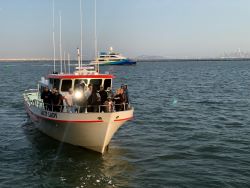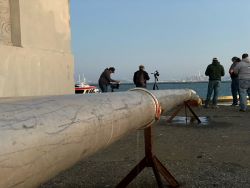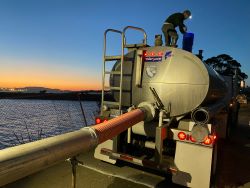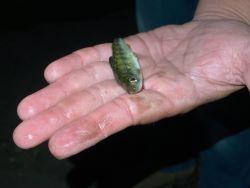CDFW staff with tanker truck used to transport smolts

The Salty Lady sportfishing boat hosted Richmond youth

Smolts being released into Richmond Harbor



Fall-run Chinook salmon smolt
Moments after the sun set on Richmond Harbor’s Brickyard Cove on June 19, CDFW and its partners released approximately 200,000 hatchery raised juvenile fall-run Chinook salmon (known as smolts) into the bay.
The release was part of a larger effort to truck approximately 19.7 million fall-run Chinook salmon to locations in the San Francisco Bay, San Pablo Bay and lower portions of the Sacramento-San Joaquin Delta. CDFW has two more smolt releases planned for the week of June 20. Since beginning the effort in mid-April, staff have completed three to six releases per week.
Sunday night’s release was a collaboration with the City of Richmond, Golden State Salmon Association and Richmond Police Athletic League. The team invited a group of young people from Richmond to watch the release from a 56-foot sportfishing boat called The Salty Lady, the use of which was donated for the event to offer youth a glimpse into fishery operations.
“These kids definitely got a unique opportunity and a front row seat to watch this release,” said Senior Environmental Scientist Jason Julienne, supervisor over CDFW’s North Central Region hatcheries. “I hope it gets them interested and excited for fish and fishing, with the hopes of catching one of these fish when they return as adults in a few years.”
The goal of the releases is to improve survival of the salmon smolts by helping them bypass 50 to100 miles of hazardous river conditions caused by three consecutive years of drought in the Central Valley. CDFW fisheries biologists tracked flows and water temperatures in the fish's usual migration corridors and recognized that survival would be a challenge without intervention.
“We want to help ensure some of these fish survive to contribute to commercial and recreations fisheries, as well as hatchery and natural area production in the coming years,” said Julienne.
The smolts, raised at CDFW’s Feather River Fish Hatchery in Oroville, were eight to 10 months old when released. At that age, the smolts are developmentally ready to handle the salinity of bay waters. The Brickyard Cove location in Richmond was chosen because of its favorable tides and proximity to deep waters.
“We try to use outgoing tidal movements and the cover of darkness to help get these fish oriented in the right direction toward the Pacific Ocean, and reduce predation,” said Julienne.
All fish from yesterday’s release were marked and implanted with coded wire tags so CDFW can track their returns and determine how they contribute to fisheries and production in coming years.
For more information read CDFW’s news release on the trucking operation.